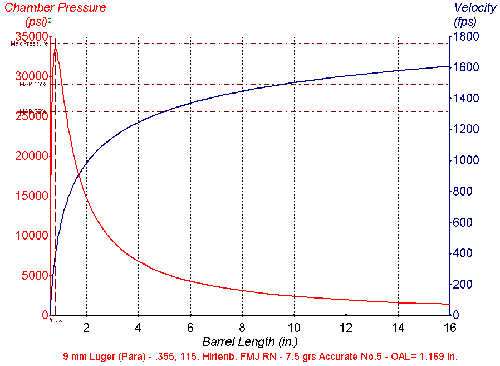9mm performance with barrel length
Seen at arfcom, a chart that shows how 9mm AR-15 velocity in feet per second changes by barrel length (thanks to Randall Rausch at www.ar15barrels.com):


Seen at arfcom, a chart that shows how 9mm AR-15 velocity in feet per second changes by barrel length (thanks to Randall Rausch at www.ar15barrels.com):

Remember, I do this to entertain me, not you.
Uncle Pays the Bills
 |
|
Find Local
|

August 30th, 2006 at 12:53 am
Nice, thanks for the pointer.
August 30th, 2006 at 1:34 am
That’s pretty neat. I wonder how whoever got all those data points. I suppose it was done with one of those strain gauge thingys. Look to see the initial pressure rise. Although it still does not explain how they know the bullet’s velocity when it is at the 8” mark in a 16” barrel.
I had initially assumed that someone took a barrel and a hacksaw and recrowned the barrel at 16, 14, 12, 10, 8…. inches, but that’s clearly not the case.
I’d love to see a bunch of charts showing pistol rounds in various carbine and wheelguns (where the bullet and the driving gases need to jump the gap).
August 30th, 2006 at 2:45 pm
Strange thing is that the plots seem to be approaching asymptotic values which would clearly be wrong. Eventually, as the length increases, the friction in the barrel will be greater than the force of the remaining pressure on the bullet, at which point the speed should drop. I’d like to see data out past that point as a sanity check.
August 30th, 2006 at 3:17 pm
Ben, I doubt you’ll see a 60 inch AR barrel.
August 30th, 2006 at 10:51 pm
Um, isn’t the AR-15 a .223 caliber rifle?
August 31st, 2006 at 6:33 am
It’s usually a 5.56 nato. It also comes in many other calibers.
September 5th, 2006 at 11:22 am
The plot above is a Quickload prediction.
It’s not strain gauge or chrongraph data.
More info on the Quickload internal ballistics software can be found on http://www.neconos.com
Randall Rausch
http://www.ar15barrels.com